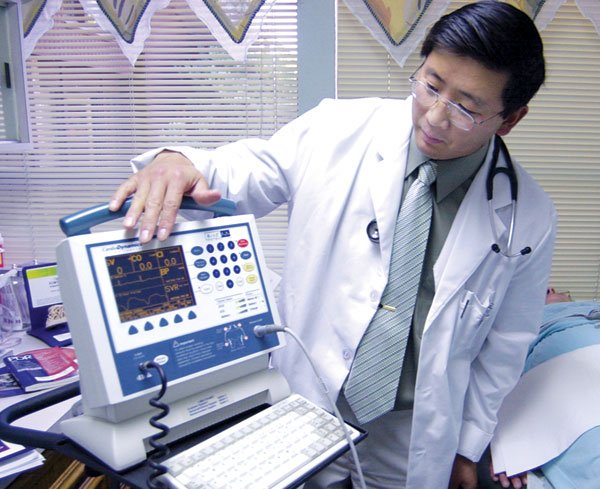Gilroy
– Ann, a 72-year-old Gilroyan, lays flat on a medical examiner’s
table and takes a deep breath. Her physician, Dr. Samuel Wu,
meticulously adheres four electrodes to her neck and ribcage.
Gilroy – Ann, a 72-year-old Gilroyan, lays flat on a medical examiner’s table and takes a deep breath. Her physician, Dr. Samuel Wu, meticulously adheres four electrodes to her neck and ribcage.
Wu tells her to relax, lay still and breathe normally. Ann closes her eyes as Wu pushes a button.
“Well, that was easy,” she says about two minutes later.
Ann is one of the first patients in Gilroy to learn vital information about her heart via BioZ, a high-tech technology used in cardiovascular checkups. The noninvasive device measures 12 different parameters of the heart including how fast blood is moving, how hard the heart is working and how much thoracic fluid is in the chest. With a limitless memory, the machine can store an abundance of patient data that is easily accessible by doctors.
Previously, patients had to undergo a process called pulmonary artery catheterization to get such detailed information. But the ordeal is time consuming, risky and uncomfortable, and Ann, for one, is happy she’ll never have to go through it again.
“This is so much better, so much easier,” she said. “You don’t feel a thing, and you’re done in five minutes.”
A long-time asthma patient, Ann has used BioZ four times. After her first exam, Wu prescribed different, more precise medications for her diagnosis. Since then, she said she feels better, has more energy and is wheezing less. Her BioZ results also have improved.
Wu is the first internal medicine doctor in Gilroy to use BioZ, and he said he’s thrilled with the technology’s abilities and benefits to reach far beyond conventional technology. While a basic clinical exam is able to detect information for heart rate, systolic and diastolic blood pressure and mean arterial pressure, BioZ targets a number of additional indicators that are less easily detected, but essential to heart health.
BioZ initially was used by NASA to monitor the cardiac output and effects of hypergravity on cardiovascular systems of space astronauts in flight. Now, more than 8,000 clinics and physicians worldwide are using the technology. Wu expects BioZ, which he credits as revolutionary, to become widespread within two to three years.
Perhaps the biggest advantage of BioZ is its acute sensitivity, which can help with early detection and prevention. Doctors are better able to detect a problem before it begins to adversely affect the patient’s quality of life, and they can prescribe medications that are more specific to the patient’s exact needs. Taking a preventative approach can help save millions in hospital bills and on Medicare, Wu said.
Hypertension or high blood pressure, for example, is the most common chronic illness in the country. It is also the most uncontrolled. Seventy percent of hypertension cases go undiagnosed, Wu said, many times because the patient does not “feel” any symptoms so they assume nothing is wrong.
Conventional technology, while able to detect hypertension, cannot tell doctors why the condition exists. But because hypertension can be attributed to several causes including genetics, diet and lifestyle, it’s often difficult for doctors to pinpoint the cause and prescribe medications accordingly. BioZ changes that.
“Trying to diagnose the problem with older technology is largely a blind target,” Wu said. “There are so many possibilities, and prescribing the right drugs was kind of trial and error. But this new technology, it allows us to see the invisibles, to reach in more hands to help. We can address the problem before it really becomes a problem.”
Another benefit of BioZ is its convenience. The machine is compact, lightweight and portable, with an internal battery and automatic blood pressure cuff. Patient data printouts make it easy for patients to see and understand how their heart is working, and then compare results to track heart health improvement, decline or stability.
Additionally, there’s no need to trek to a hospital or clinic to receive a BioZ exam, which further helps patients feel at ease and more comfortable while taking the exam.
Developed by San Diego-based CardioDynamics International Corp., the device will set doctors back about $40,000. Although the investment is well worth it, Wu said, some physicians simply can’t afford it. On the patient side, the BioZ exam is covered by Medicare and some private insurance companies, but not all. Wu said he expects that will change once the technology is more widely adopted. For now, Wu said, walk-in patients with no insurance can get a BioZ reading for about $15.














